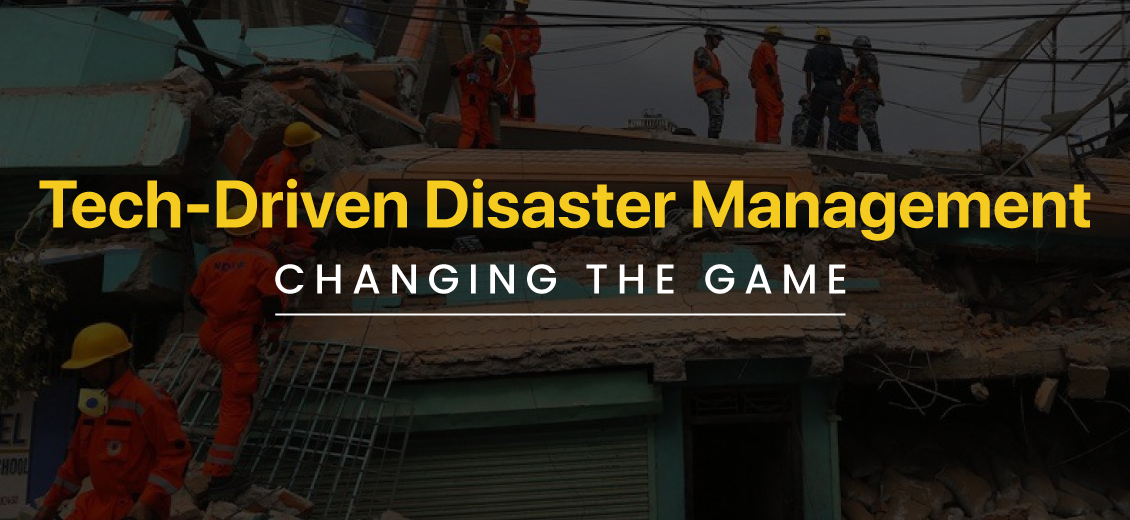Tech-Driven Disaster Management: Changing the Game
Blogs Home
- 21 Aug 2023

Disasters are sudden, catastrophic events that cause significant disruption, damage, and loss. Broadly categorized, they fall into two groups: natural and man-made. Natural disasters include hurricanes, earthquakes, floods, and tsunamis. Meanwhile, man-made disasters encompass events like nuclear accidents, terrorist attacks, and oil spills.
For a country's long-term stability, disaster management is paramount. It bolsters resilience, ensuring communities bounce back swiftly post-disaster. Additionally, prioritizing disaster management ensures sustainable development, laying the foundation for a secure, prosperous future.
Over the years, technology has reshaped disaster management. Drones now survey disaster-stricken areas, while early warning systems help preempt calamities. The evolution of data analytics and artificial intelligence further aids in prediction and response, making interventions timely and more effective.
Early Warning System
Technology today plays a pivotal role in establishing early warning systems for an array of disasters. For earthquakes, we use seismographs to detect tremors. Satellites and hydrological models help predict floods, while meteorological data forecasts cyclones well in advance.
Here are some successful applications of early warning systems:
- Japan's earthquake alert system stands out, providing seconds to minutes of warning before a tremor hits, saving lives and infrastructure.
- Bangladesh's cyclone warning system has significantly reduced fatalities by ensuring timely evacuations.
- In Europe, the European Flood Awareness System (EFAS) offers early flood predictions, aiding in swift response and mitigation.
Establishing early warning systems isn't without challenges. Ensuring accurate predictions, managing high installation costs, and creating public awareness can be daunting. However, international collaborations, investment in research, and community-based education can pave the way for more effective and widespread warning systems.
Leveraging Remote Sensing & GIS in Disaster Management
Remote sensing emerges as a superhero in disaster monitoring and assessment. Satellites and drones capture real-time data, providing invaluable insights into disaster magnitude and progression.
GIS (Geographical Information Systems) shines brightly in disaster management too. Its applications streamline disaster preparedness, orchestrate rapid response, and ensure efficient recovery efforts by mapping affected areas and resources.
Past disasters bear witness to these technologies' might. Satellite imagery during the 2004 Indian Ocean Tsunami detailed coastal changes, facilitating effective relief. Similarly, GIS data post-Hurricane Katrina in 2005 played a vital role in identifying inundated regions and directing aid effectively.
Deep Diving into Big Data & AI's Potential in Disaster Response
Big data analytics and AI aren't just enhancing disaster response operations; they're revolutionizing them. By tapping into diverse datasets—from social media to meteorological data—these technologies spot anomalies and potential threats even before they escalate.
Artificial intelligence, especially machine learning, is becoming more significant in the field of disaster risk reduction. Its roles include predicting extreme events, creating hazard maps, real-time event detection, offering situational awareness, aiding decision-making, and more.
Beyond basic prediction, machine learning offers intricate disaster modelling. It processes decades of disaster data to simulate scenarios, helping authorities prepare for previously unthinkable events.
But the true genius of AI lies in its adaptability. As situations evolve, AI models adjust their predictions, ensuring that relief strategies remain relevant. Moreover, natural language processing, another AI branch, now scans social media in real-time during disasters. This provides ground-zero updates, enabling faster responses to emerging threats or pleas for help.
When planning for emergencies, AI isn't just a tool; it's a team member. AI-driven simulations guide strategy, data-driven dashboards help monitor resource allocation, and automation speeds up the once time-consuming tasks. Through these advancements, we're witnessing the dawn of a new era in disaster response and preparedness.
Empowering Disaster Relief through Communication Technologies
Effective communication during disasters is a lifeline. It connects the stranded, informs the anxious, and coordinates the rescuers, often making the difference between life and death.
Enter modern communication technologies. Satellite phones defy conventional network challenges, ensuring that responders remain connected in the remotest of locales. Social media acts as a beacon, broadcasting SOS messages, and real-time updates, and mobilizing global support. Mobile apps, tailored for disaster scenarios, help in tracking, resource allocation, and even medical first response.
But the story doesn't end here. Information and Communication Technology (ICT) plays a pivotal role in knitting together a web of aid. By seamlessly connecting affected communities with relief agencies, ICT ensures that help is not just on the way, but it's on the right path, reaching those who need it the most. Through technology, humanity's response to nature's fury becomes swifter, smarter, and more compassionate.
Drones and Robotics: The Future of Disaster Recover
Drones are proving invaluable in the aftermath of disasters. With the ability to swiftly survey vast areas, they've become key players in damage assessment and search-and-rescue missions, capturing real-time aerial footage that accelerates response times.
On challenging terrains and hazardous environments, robots take center stage. Whether it's navigating the rubble of an earthquake or venturing into radioactive zones, robotics ensures safety while assisting in crucial recovery efforts.
Cybersecurity: A Pillar of Effective Disaster Management
Today’s interconnected world amplifies the importance of cybersecurity in disaster management. Our critical infrastructure—hospitals, transportation, and communication networks—increasingly relies on digital systems. A cyber breach during a disaster could spell double jeopardy, stalling response and exacerbating crises.
Emergencies can be a goldmine for malicious cyber actors. As attention diverts, they might launch attacks, spread misinformation, or compromise essential services. During the 2017 WannaCry ransomware attack, for instance, critical services like healthcare institutions in the UK were disrupted, emphasizing the nexus between cybersecurity and public safety.
By establishing robust cybersecurity protocols, disaster management agencies fortify their ability to maintain communication, protect sensitive information, and deploy resources efficiently. This proactive approach ensures that when disasters strike, the systems in place remain resilient, preserving the capacity to mitigate, respond, and recover without succumbing to the additional challenge of cyber threats.
Case Studies and Success Stories
- Haiti's Mobile Data Collection after Earthquake: Following the devastating earthquake in 2010, Haiti faced immense challenges in gathering accurate data to coordinate relief efforts. The use of technology, specifically mobile phones, played a pivotal role in this scenario. Organizations like Ushahidi employed crowdsourcing to map out areas in need of assistance using SMS and social media reports. This tech-driven approach allowed responders to target aid efficiently, ensuring that resources reached the right places.
- India's Flood Management with Remote Sensing: India's experience with monsoon-induced flooding led to the adoption of remote sensing technology. By leveraging satellite data, weather forecasts, and Geographic Information Systems (GIS), the government can predict flood-prone regions and plan evacuation strategies. For instance, during the Kerala floods in 2018, remote sensing enabled real-time monitoring of water levels, aiding rescue operations and resource allocation.
- Chile's Earthquake-Resistant Building Designs: Chile, located along the Pacific Ring of Fire, has integrated technology into architectural practices for disaster resilience. Advanced engineering techniques, including seismic-resistant building designs, have significantly reduced casualties during earthquakes. The incorporation of sensors in buildings helps detect structural weaknesses, allowing timely repairs to prevent potential collapses.
In these cases, technology has proven instrumental in disaster management and response, demonstrating the power of innovation in saving lives and minimizing the impact of natural disasters.
Policy and Governance for Tech-Driven Disaster Management: Shaping a Resilient Tomorrow
In the era of rapid technological advancements, disaster management is no exception. Governments worldwide have the power, and arguably the responsibility, to propel this momentum. How? By shaping policies and regulations that encourage the adoption of cutting-edge technologies in disaster management.
Setting the Scene with Policies and Financial Incentives: Government policies can act as a guiding star. By defining clear standards and frameworks, they provide a roadmap for technology's integration into disaster management strategies. Governments can promote tech adoption by offering tax breaks, grants, or funding to organizations or startups focusing on tech-driven disaster solutions.
Regulations as Catalysts: Think of regulations as the safety nets that ensure that technology is used ethically and efficiently. These can set parameters to ensure that tech solutions meet specific safety, privacy, and efficiency standards.
Effective disaster management is not a solo endeavour. It's a concert, and the most beautiful symphonies come from the seamless collaboration of government agencies, the private sector and civil society.
- Government Agencies: They lay the groundwork, ensuring infrastructural and logistical support. They can also offer resources, personnel, and most importantly, a regulatory framework that enables other stakeholders to join hands.
- Private Sector: Innovation is their forte. From drones that deliver relief materials to AI-driven predictive analytics that forecasts disasters, the private sector brings in fresh solutions that can be scaled and refined.
- Civil Society: Grassroot organizations, NGOs, and community groups play a crucial role in bridging the gap between technology and its end-users. They can help in the customization of tech solutions based on local needs, ensuring they're both effective and culturally relevant.
The key here is open communication. Regular dialogues, workshops, and joint initiatives can foster an environment where knowledge and resources are shared, leading to holistic disaster management solutions.
Navigating the Challenges in Tech-Driven Disaster Management
The path to tech-driven disaster management is not without its hurdles. Recognizing these challenges is the first step in addressing them.
- Financial Constraints: While technology promises efficiency, it also comes with a price tag. Limited budgets can often hinder the full-scale adoption of advanced tech solutions.
- Technical Know-how: Not every disaster management professional is tech-savvy. The gap in tech knowledge can lead to underutilization or even misuse of the tools at hand.
- Cultural Resistance: In many regions, there's an inherent trust in traditional disaster management methods. Introducing technology can meet resistance, as it's seen as disruptive or untested.
- Interoperability Issues: With multiple stakeholders involved, ensuring that different tech systems "speak" to each other can be a challenge. This can lead to data silos and inefficiencies.
Overcoming these challenges requires a proactive approach. Continued training, piloting new technologies, allocating funds for research and development, and fostering a culture of openness to innovation are just a few ways to ensure that tech-driven disaster management initiatives thrive.
Closing Words
The path to a disaster-resilient future is illuminated by technological innovation. As we stand on the precipice of this brave new world, it's our collective responsibility to harness these tools judiciously, always striving for a safer, more prepared global community. The future beckons with promise, and with a concerted effort, we can ensure that it's a future where humanity stands tall, even in the face of the harshest adversities.
Sources:
- https://www.ncbi.nlm.nih.gov/pmc/articles/PMC3168873/
- https://www.iirs.gov.in/iirs/sites/default/files/upload/document/Kerala_Flood_Sep18a.pdf4
- https://www.weforum.org/agenda/2023/03/how-to-make-buildings-earthquake-proof-chile-japan/
- https://www.worldbank.org/en/news/feature/2013/10/17/india-cyclone-phailin-destruction-preparation
- https://www.theguardian.com/society/2017/may/12/hospitals-across-england-hit-by-large-scale-cyber-attack
- https://public.wmo.int/en/resources/bulletin/artificial-intelligence-disaster-risk-reduction-opportunities-challenges-and
- https://www.sciencedirect.com/topics/computer-science/hurricane-katrina
- https://www.preventionweb.net/files/43291_sendaiframeworkfordrren.pdf
- https://www.preventionweb.net/sendai-framework/sendai-framework-at-a-glance
Shounak Roy

He finds pleasure in the hunt for knowledge, eagerly seeking to learn something new about anything that interests him. He describes himself as a simple and peaceful individual, always curious to delve deeper into various subjects. If he comes across someone with shared interests, he enjoys engaging in discussions and exchanging knowledge.
Blogs Home



